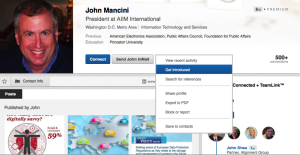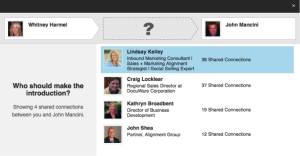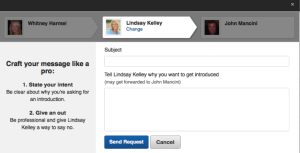The first week at any new job is often the same – you’ll meet with the HR Manager, the IT department will get you set up with the necessities such as email and software applications designed to create success, and your boss will give you the lay-of-the-land. But then the first week is over and it’s time to be a productive member of the team!
Switching jobs often means jumping into the unknown, and more than likely as a sales professional you’ll be asked to target new business. How you go about this can mean the difference between scrambling at the end of each quarter to hit your quota, or hitting it out of the park.
When I first started my sales career (10 years ago this past Sunday), things were very different than they are today. I regularly knocked on doors, hoping that my smiling face and business card would grab the attention of whoever I shook hands with, or I’d try calling a CEO at 6:00pm because he or she was likely to be in the office. Some companies still host cold-calling blitzes where each sales rep makes as many dials as they can and whoever sets the most appointments wins a small prize. I’m not saying that these tactics don’t hold some value today, but I believe there are more efficient and smarter ways to connect with prospects and customers in order to drive business.
We’ve all heard that it’s not about what you know, but who you know. Take a minute to think about the people who you have relationships with or someone that you’re connected to. Do you have friends from high school and college? What about a religious organization or the non-profit that you support. Surely you have relationships with clients new and old. But are you using those connections to drive business?
Strong Connections Are Powerful
Consider who’s in your network and how well you know those contacts. I encourage you to reach out to these individuals on LinkedIn and ask them to catch up over coffee or find 15 minutes to chat about their company and your new role. Connecting with someone one-on-one is a powerful way to grow your network and ultimately grow your business. Not everyone you speak with is going to be a prospect, but they can be an advocate, supporter or center of influence.
The Value of 2nd Connections!
Next, you should look at the people that you’re already connected to and check out their connections. If you have relationships built around trust, try reaching out to those in your network and ask for a few introductions. The idea is that a warm intro is always better than a cold-call, and who better to make that happen than someone you trust.
Try the Three-by-Three Method
Start by picking three centers of influence in your network. Look through their connections and find three people you’d like to be introduced to (these people are your 2nd level connections). Go to that person’s page and click on the arrow next to “Send InMail.” Use the drop-down menu to select “Get Introduced.”
Next you’ll see a list of your mutual connections. Click on your center of influence.
Follow the two rules that LinkedIn provides when asking for an introduction. Be clear and concise with your intentions and give that person an “out” in the event they aren’t comfortable making the intro. There are any number of reasons why someone wouldn’t, and that’s okay. If you have other mutual connections, ask someone else.
Preparation is Required Before any Appointment
High-level Executives don’t have time to meet with everyone who calls them, nor do they want to. They’re more likely to take an appointment with someone that was referred to them. And it’s important to use that time wisely to bring value to the conversation. Before the meeting, you’ll want to do the following:
1. Research the prospect by reviewing their personal LinkedIn profile as well as their company’s LinkedIn page.
2. Take notice of their professional & volunteer experience, skills, schools attended and the Groups they’re involved in.
3. Find something that you have in common and use that to naturally build rapport.
4. Read their summary and a few articles that were recently posted.
It’s crucial to educate yourself before a meeting to ensure that you’re putting your best foot forward. Executives and decision-makers will appreciate that you’re prepared!
LinkedIn is a tool that professionals in any industry can use to show value, grow sales, and target potential clients. When starting a new job as a business development or sales professional, use your network to target prospects and connect others. Always be prepared to bring value to any relationship and think about what you can do for them, more than what they can do for you. Be sure to keep track of your successes with LinkedIn and send a personalized thank you to anyone who’s referred you.
Starting a new sales job and developing new business doesn’t have to be intimidating if you use LinkedIn the way it was designed. Make it a point every week this month to try the Three-by-Three Method and let us know the outcome. We’d love to hear your success stories in the comments below. Good luck and happy connecting!






